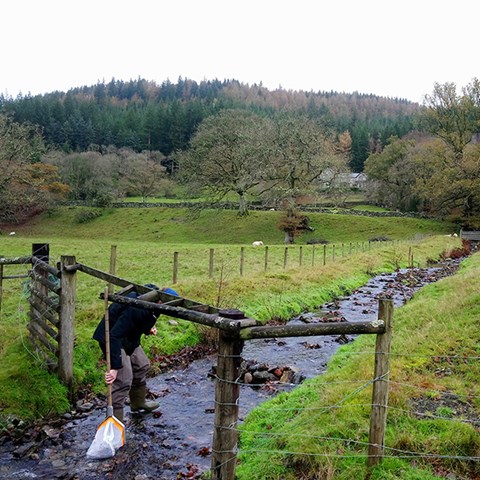Biodiversity in watercourses is better monitored with environmental DNA

Studies of macroinvertebrate fauna are an important part of environmental monitoring of watercourses. Today, samples are often taken using a net, followed by a manual examination of the diversity of insects, crustaceans, worms and other invertebrates that are visible to the naked eye. A new study shows that analysis of eDNA from water samples is a faster and cheaper method that also provides a more detailed picture of biodiversity.
Environmental pollutants affect the composition of the macroinvertebrate fauna in watercourses and lead to a gradual shift in the distribution between organisms that are sensitive and tolerant to pollutants. Assessments of the ecological status utilize these known differences in tolerance in different types of macroinvertebrates to determine water and environmental quality.
However, sampling and species determination of the macroinvetebrate fauna is time-consuming and requires expert knowledge. Also, many species that are aquatic in the larval stages may be almost impossible to distinguish from each other at different life stages.
Today, there are big hopes that new genetic methods can help us determine quickly, and with high precision, which organisms are present in the environment. The use of "environmental DNA", or eDNA, has developed strongly over the last decade, and today DNA sequences from a few drops of filtered water may be sufficient to give a picture of which species live in the water, provided that there are "DNA barcodes” for the species you are looking for.
The first major comparison of spatio-temporal environmental monitoring of watercourses in a practical setting with new and traditional methods has recently been published from research led by Mathew Seymour, a postdoctoral fellow at SLU's Department of Ecology. The study was conducted in a catchment area in North Wales, and covered both seasonal variations and areas with different land uses.
“We show that environmental monitoring based on eDNA is a powerful, rapid and effective strategy”, says Mathew Seymour. “It is possible to make complex studies of how biodiversity and ecosystem functions vary in time and space along a watercourse in a way that is infeasible using traditional methods.”
“In addition, this "forensic" method is more gentle on the environment”, he points out. “By using the DNA traces that the macroinvetebrate fauna releases into the water, we don’t need to disturb the environment and take the organisms back to the lab. We also reduce the risk of unintentionally spreading diseases between watercourses with insufficiently disinfected nets and other tools.”
In several countries, but not Sweden, authorities have adopted eDNA sampling as a component in the monitoring of aquatic environments. The best-known examples are measures against the invasive Asian carp in the US and the conservation of the great crested newt in the UK.
“There are authorities working on the issue in Sweden, as well as groups within SLU”, says Mathew Seymour. “I myself participate in a newly started project that is about monitoring amphibians – especially the European green toad on Öland – together with SLU Swedish Species Information Centre and Nordens Ark.”
More information
Mathew Seymour, Postdoctoral Fellow
Department of Ecology, Unit for Insect Ecology
Swedish University of Agricultural Sciences, Uppsala
https://www.slu.se/en/ew-cv/mathew-seymour2/
The article
Mathew Seymour et al. Environmental DNA provides higher resolution assessment of riverine biodiversity and ecosystem function via spatio-temporal nestedness and turnover partitioning. Communications biology (2021) 4: 512, https://doi.org/10.1038/s42003-021-02031-2
Press image
(May be published without charge in articles about this press release, please acknowledge the photographer).
Traditional sampling of macroinvertebrates with a net in a stream surrounded by Welsh pasture. Photo: Mathew Seymour